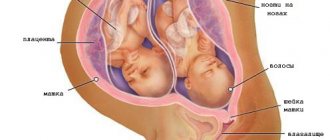Fetal development at 31 weeks of gestation
Fruit size:
41 cm.
Fetal weight:
1700
The birth is getting closer, you only have nine weeks left. Now you need to always carry an exchange card and your documents with you, since sometimes labor can begin ahead of schedule. And although the baby still needs to mature and grow, if he is born now, his chances for a normal healthy life are very high, he will only need some help from doctors. Your body has changed a lot, it’s already hard for you to carry your tummy, now that you are already on maternity leave, you need to devote more time to yourself and the baby in your tummy.
31 weeks, how many months is that? At the 31st obstetric week, the 7th month of pregnancy ends. Gynecologists consider the completion of the 7th month at a period = 30 weeks and 6 days). The 3rd trimester of pregnancy continues.
Weight, height, fetal development at 31 weeks
This week the baby weighs about 1700 grams, and reaches a length of up to 41 cm. The baby weighs as much as a coconut.
By this time, all the main organs and systems of the child have already formed and began to work more harmoniously. Now the baby’s development is mainly aimed at gaining weight and strengthening muscles. The rate of its growth slows down somewhat. A layer of fat appears under the child’s skin, as a result of which the folds and wrinkles on his body are gradually smoothed out.
The subcutaneous fat layer on the cheeks of the fetus is especially well developed. But if suddenly the baby begins to lose weight, then first of all the fat will leave these areas, which will make it easier to suck on the mother’s breast.
In the future, subcutaneous fat in the newborn will perform a thermoregulatory function, protecting it from freezing. The vernix lubrication is still present on the baby's skin, but its amount is decreasing.
By the time of birth, most of it will completely disappear along with the lanugo fluff covering the baby's body. As in previous weeks, during this period the brain is actively developing and growing.
The process of formation of furrows and convolutions, differentiation of the centers of its cortex continues. It is interesting to note that by 31 weeks the fetal brain weight is almost a quarter of the adult brain weight. The baby's senses continue to develop. He can breathe by inhaling and exhaling amniotic fluid.
By the way, the child’s olfactory receptors begin to function, thanks to which he can smell and even taste amniotic fluid, which will depend, in particular, on the nutrition of the pregnant woman. For example, eating garlic and other spicy or pungent foods may not be to the child’s taste and cause a violent reaction.
At 31 weeks, the baby’s pupils still react only to light and darkness. When exposed to too bright lighting, the baby may even close his eyes, and he will learn to distinguish colors only some time after birth.
Also, by this time the tear ducts open, so the baby is already able to cry. Pigment continues to accumulate in the hairline and iris of the eyes, which determines the color of the child’s eyes. In the iris, the accumulation of melanin is slower, so many children are born with light gray-blue eyes, and the genetically determined eye color is established by about 6 months after birth.
If you give birth at 31 weeks, the baby will need good medical care. He will be considered premature and will have a chance of survival. In a child at this age, the lungs are not mature enough, and the subcutaneous fat layer is poorly developed. Procedures such as placement in an incubator and artificial ventilation are necessary.
Discharge
Amniotic fluid may leak in small portions or pour out in a stream. You will not miss the second symptom of approaching labor, but in the first case, the woman is not always able to recognize leakage. Water should normally be clear and liquid, odorless. Today, pharmacies sell special tests to determine water leaks at home. In a clinical setting, a woman can also undergo a similar study, and if suspicions are confirmed, she will be admitted to the hospital. Therefore, such discharge should alert you.
The third trimester is the time for a complete medical examination before childbirth. This primarily concerns sexually transmitted infections, since they pose a threat to pregnancy in general and the baby in particular. That is why the gynecologist will again take a smear from your vagina to determine the pathogenic flora.
Very often, expectant mothers develop thrush in later stages. To avoid this, do not forget about the dietary recommendations: they remain in force until the very end, and control of the consumption of flour and sweet products is one of the main ones. Also, stop using panty liners - it’s better to change your underwear more often, which, by the way, should be exclusively natural!
The development of thrush is indicated by white cheesy or mucous discharge that smells like beer, yeast or fish. Such discharge usually causes terrible discomfort to a woman: irritation and swelling of the genital organs, itching, burning, pain. Candidiasis should certainly be cured before birth, since during the passage of the child through the birth canal it will become infected, and this is fraught with consequences.
You should pay attention to discharge at 31 weeks of pregnancy, since the risk of contracting other sexually transmitted infections remains quite high. Any changes in leucorrhoea - its color, consistency, smell, and especially the appearance of additional suspicious signs - must be double-checked by taking a vaginal smear.
The appearance of traces of blood on underwear should also alert you. Sometimes an anal fissure or inflamed hemorrhoids begin to bleed. A small amount of blood from the vagina may normally be released after sexual intercourse or within a few hours after a gynecological examination. But also bleeding of varying intensity (including spotting) may indicate a threat of premature birth, especially when accompanied by other symptoms and warning signs, for example, nagging pain radiating to the lower back.
Ultrasound at 31 weeks of pregnancy
At 31-34 weeks, pregnant women undergo a third ultrasound scan. If there are certain indications, specialists prescribe additional ultrasounds. During the study at 31 weeks: presentation is determined; the values of fetometric indicators are determined; Fetal anatomy is assessed; the location of the placenta, its thickness are determined, the entanglement around the fetal neck is revealed; an assessment of the motor activity of the fetus is given.
The third ultrasound is the final monitoring of the condition of the fetus, its position, assessment of the functionality of the placenta and the choice of method of delivery. This routine ultrasound examination most often shows the following abnormal conditions:
- the fetus is in a transverse position;
- the fetus is in an oblique position;
- placenta previa;
- polyhydramnios;
- diseases that had not previously been identified.
The ultrasound also evaluates the anatomy of the fetus. Here the internal organs are indicated and it is noted whether they are normal or whether there are any pathological changes. The document also provides characteristics of the placenta. They reflect its ability to supply the fetus with all the necessary substances.
What does ultrasound show and the norm at this stage?
Ultrasound diagnostics can monitor the external development of the fetus. Thanks to it, fetometry of the fetus is performed at 31 weeks - the size of the fetus, the length of its bones, as well as other structural characteristics presented in the table are determined.
| Measuring the main bones | Normal indicators |
| Hip | 5.5–6.5 cm; |
| Shoulder | 5–6 cm; |
| Forearm | 4.5–5.3 cm; |
| Shin | 5–6 cm. |
Norm of other measurements:
| Abbreviation of measurement | Normal indicators |
| BPR | 7.3–8.7 cm; |
| LB | 9.3–10.9 cm; |
| OG | 27.3–21.5 cm; |
| coolant | 24.7–30.1 cm. |
Explanation of sizes and girths:
- BPR – biparietal;
- LB – fronto-occipital;
- OG – head circumference;
- AB – abdominal circumference.
An ultrasound machine allows you not only to see the child, but also to determine his height, weight and other parameters
The normal weight of a child on ultrasound is 1300–1800 grams. Normal height is 38–42 centimeters.
Doppler indicators
Indicators and interpretation of ultrasound at the 31st week of pregnancy are shown in the table.
| Dimension name | Decoding | Permissible value |
| IR of the uterine arteries | Index of blood flow resistance in the uterine arteries | 0,34–0,61 |
| PI of the uterine arteries | Uterine artery pulsatility index | 0,53–1,51 |
| SDO of the uterine arteries | Systole-diastolic ratio in the uterine arteries | up to 2.3 |
| IR umbilical artery | Umbilical cord artery blood flow resistance index | 0,53–0,76 |
| PI umbilical artery | Umbilical cord artery pulsatility index | 0,71–0,99 |
| SDO of the umbilical cord artery | Systole-diastolic ratio of the umbilical artery | up to 3.2 |
| PI in the middle cerebral artery | Pulsatility index in the cerebral artery | 1,51–2,43 |
| SDO in the middle cerebral artery | Systole-diastolic ratio in the cerebral artery | not less than 2.4 |
If you deviate from these standard indicators, there may be serious pathologies that require the attention of doctors, as well as additional examination.
Why you need to undergo CTG during pregnancy you will learn from this video:
CTG
CTG at the 31st week of pregnancy is an important part in examining the fetus. Using cardiotocography, uterine contractions, fetal heartbeat, and the presence of any abnormalities or pathologies are recorded. An experienced specialist deciphers the resulting graphs, which show the current situation. Based on the results obtained, the doctor evaluates several parameters (rhythm, amplitude, deviations, etc.) and sums them up. The scores obtained indicate the baby’s condition:
- 8–10 – are normative indicators of cardiotocography;
- 6–7 – there are minor pathologies in the child, which is the basis for additional research;
- 5 or less – there are obvious violations, which require immediate hospitalization.
Read also: Cardiotocography of pregnant women.
When studying the charts, the doctor first looks at the average value of the basal rhythm, which shows the condition of the fetus.
Feeling and condition of a pregnant woman at 31 weeks
At 31 weeks of pregnancy, a change in appearance also occurs. Many mothers note that their hair and nails grow faster, their skin looks healthy and glowing. This occurs due to the increased production of estrogen, the female sex hormone. Sometimes the condition of the skin, on the contrary, worsens - acne, vascular networks, and pigmentation appear on it.
You should select cosmetic products carefully, after consultation with a dermatologist, as they may contain substances that are undesirable for use during pregnancy.
The breasts enlarge and change shape. This occurs due to the growth of the milk lobes, which are preparing for many months of feeding the baby. Over the entire period of pregnancy, the breasts will become heavier by 0.5-1.5 kg.
At this stage, pain in the lower back often occurs, heartburn, nausea, constipation, and flatulence are a concern. Urine acquires an unpleasant odor and a dark yellow color; laboratory diagnostics show the presence of salts and an increased amount of protein in it.
The doctor will most likely diagnose pyelonephritis in pregnant women. Under no circumstances should the disease be neglected, since the bacteria that has infected the kidneys can penetrate the placenta and infect the child, which can lead to damage to his organs and developmental disorders.
To prevent this, gentle antibacterial drugs can be prescribed that will neutralize the infection without harming the child. Due to the increase in fluid volumes in the body, the load on the kidneys increases.
If before pregnancy a woman suffered from chronic diseases of the urinary system, they will almost certainly make themselves felt.
As the uterus grows, it will rise higher, supporting the diaphragm and ribs and causing discomfort to the woman. Despite the fact that at the 31st week the size of the abdomen is not yet too large, it already has a negative impact on the posture of the pregnant woman. Due to a shift in the center of gravity, the expectant mother's spine becomes arched, her gait becomes heavier, and lower back pain appears.
However, you should not rush to buy a bandage until the baby turns upside down, and to alleviate your condition, you can purchase special compression tights for pregnant women.
On average, by the 31st week of pregnancy, the expectant mother should gain 7.5-10.5 kg. If this does not happen, the doctor may order additional tests to check the amount of amniotic fluid. It should be about 1 liter, but with polyhydramnios it can exceed 2 liters, and with oligohydramnios it can be reduced to 500 ml.
Sensations and changes in the female body
The tummy grows, continuing to put pressure on everything around. Shortness of breath, heartburn, some painful spasms in the lumbar region and ribs became companions of pregnancy.
Female body
The biggest load is on the legs. Try to help your legs whenever possible, rest more often, and thereby you will prevent swelling of the legs. To prevent swelling of the legs, use these small recommendations:
- whenever possible, try to place your feet on the surface higher than your stomach;
- do not wear tight shoes and clothes;
- regularly monitor your health, that is, how your kidneys are working, take a urine test;
- limit the amount of salt in food;
- control the intake of fluid into the body, no more than 1.5 liters per day;
- As prescribed by your doctor, you can start wearing compression tights.
The gait becomes similar to swaying from one foot to another. This happens because your body produces the hormone relaxin, which makes the bones of the hip part softer, so that the baby has an easier time going through the birth canal. After childbirth, your gait will change.
Continue to monitor the baby's movements, he has become less active, but his movements should be noticeable about 20 times a day. If the child moves very actively, this may indicate a lack of oxygen in the little body, it is better to consult a doctor. Do not forget that if the tummy is twitching, it is just the baby hiccupping, it will go away in a few minutes.
In order to relieve back pain and reduce the load on your growing belly, do not neglect the bandage. But to do this, first ask your doctor how your baby is lying. If the baby lies in a longitudinal presentation with his head down, then the bandage can be worn. If the baby has not yet turned, refrain from wearing the bandage until he is in the correct position.
Possible risks and dangers of 31 weeks
As for the risks at 31 weeks, there are enough of them, since it enters the fourth critical period of pregnancy.
So, if at this stage of pregnancy a woman receives too little vitamin D, in the future this may provoke the development of rickets in the child. A lack of calcium in the diet leads to its leaching from the walls of the mother's blood vessels, which causes the development of varicose veins.
The danger comes from exceeding the permissible weight gain. It often leads to postpartum obesity, metabolic syndrome and even type II diabetes.
In the third trimester, the likelihood of developing the most dangerous complications of pregnancy – preeclampsia and eclampsia – increases sharply. It is preceded by gestosis , a condition with unclear pathogenesis and etiology. Its main symptoms are increased blood pressure, the appearance of protein in the urine and swelling of the arms, legs and face.
There are no treatments for this condition, so the doctor simply monitors the patient and tries to reduce the symptoms as much as possible. If the complication progresses, preclampsia may begin.
Its symptoms are a strong increase in blood pressure, nausea and vomiting, headache and characteristic “floaters” before the eyes . If the condition cannot be normalized, early surgical delivery is performed. If you do this on time, the chances of saving the life of a woman and child are very high.
If you don’t go to the hospital in a timely manner or the symptoms increase too intensely, doctors may not have time to react, and then eclampsia - convulsions. A woman may die during or after an attack from hemorrhage, asphyxia or pulmonary edema. The fetus also often dies from hypoxia.
Sex
After 30 weeks of pregnancy, some mothers and fathers begin to gradually curtail their sexual activity. Undoubtedly, the emotional and physical state of a “pregnant” couple is constantly changing; this, of course, largely concerns the woman. But often it is men who begin to avoid intimacy in later stages.
31 weeks pregnant video
31 weeks pregnant photo
It will be useful for both parents to know: if there are no medical contraindications to sex, the mother feels great and lovemaking does not cause her any discomfort, then sex at 31 weeks of pregnancy is not prohibited. If you are careful, it will not harm the baby, since it is protected by reliable armor in the form of the pubic bone and the thick wall of the uterus.
Don't be alarmed by possible scanty bleeding after sex, but next time be more careful. Penetrations and frictions should be shallow, smooth and gentle. The most favorite, safe and comfortable positions at 30 weeks are with penetration from behind. Otherwise it will be inconvenient: the tummy becomes a real obstacle to physical intimacy in the literal sense of the word.
Recommendations for a pregnant woman at 31 weeks
- To maintain energy and good health, walking in the fresh air and moderate exercise are very useful. The main thing here is not to overdo it and not get yourself tired. The best options for physical activity during this period are swimming, fitness for pregnant women, and fitball exercises.
- There is no need to try to redo all your homework at once, this can have a bad effect on your well-being.
- Avoid any pressure on the abdomen. Tight clothing can cause vasospasm, which can cause the child to experience insufficient weight gain and developmental delays. For the same reason, it is not recommended to sleep on your back.
- Learn to get out of bed slowly. Sudden movements can cause pain. If you pay attention to your posture, you can significantly reduce back pain.
- If you are often plagued by fears and worries, talk to someone about it. By sharing your worries, they will no longer seem so serious.
- In case of tired legs and lower back pain, do the exercise - knee-elbow position, that is, stand on all fours with your shoulders and head down. In this position, the spine relaxes and does not feel the load on the abdomen. It also helps to normalize the tone of the uterus and improve the supply of oxygen to the baby.
- Don’t forget to visit your doctor; now you go to the antenatal clinic much more often. Now it is very important to control your weight and blood pressure. Follow all advice from your gynecologist.
- If you experience pain in the abdominal area, bleeding from the vagina, or the onset of contractions, you should immediately seek medical help, as these are symptoms of premature labor. It is recommended to always have an exchange card with you.
- From 31 weeks, expectant mothers can attend courses for pregnant women. Maternity clinics offer good courses free of charge.










